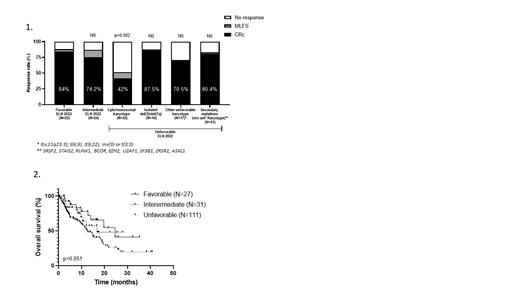Azacytidine and venetoclax combination regimen (AZA/VEN) is the standard of care in frontline acute myeloid leukemia (AML) settings for unfit to intensive chemotherapy patients. However, AZA/VEN is also associated with an increased hematological toxicity compared to azacytidine alone. In this context, alternative AZA/VEN regimens emerged progressively based on each physician experience and local procedures. Moreover, AZA/VEN is also recognized as a valuable therapeutic option in relapse/refractory settings. In this multicentric study, we aimed to evaluate the efficacy and safety of various AZA/VEN regimen in frontline and relapse/refractory (R/R) patients diagnosed with AML in real life setting.
We retrospectively analyzed 331 patients from 11 different French centers (Saint-Etienne, Clermont-Ferrand, Lyon (Hopital Lyon Sud, Centre Léon Bérard), Vichy, Annecy, Chambery, Valence, Bourgoin-Jallieu, Grenoble, Roanne) in Auvergne Rhône Alpes (AURA) region, between January 2019 and February 2023. Composite complete remission was defined as in VIALE-A trial. Measurable residual disease (MRD) negativity was defined as ≤ 10 -3 by flow cytometry (on bone marrow) and/or ≤ 10 -4 for NPM1 by RT-qPCR.
Overall, the entire cohort was composed of 186 and 146 patients in frontline and R/R settings respectively. In frontline setting, median age was 74.5 (19.1-86.1) and ELN 2022 risk groups were favorable, intermediate and unfavorable in 14.5, 16.7 and 68.8% respectively. De novo AML, MRC-AML, post-MPN/MDS AML and t-AML were 32.4%, 29.7%, 23.2% and 14.5% respectively. After 6 cycles, median CRc, morphologic leukemia free state (MLFS) and refractory rate were 66.4%, 5.4% and 28.2% respectively. Regarding probability of CRc, there was no significant difference between favorable and intermediate ELN 2022 risk group. Within unfavorable risk group, only complex karyotype was associated with lower CRc rate ( figure 1). Venetoclax dosage (400mg vs 100mg/d) and duration per cycle (28 days vs 21 days vs others) did not influence significantly CRc rate probability and OS. With a median follow-up of 7.3 months, median overall survival (OS) was 12.4 months (IC95%: 3.4-18.5). There was no significant difference in terms of OS according to ELN 2022 risk group classification ( figure 2). Among unfavorable risk group, only patients with unfavorable karyotype had a worst OS (median OS: 4.9 months), while patients with secondary AML mutations had similar OS than favorable/intermediate risk group (19.5 vs 20.2 vs 18.2 months, p=0.32). Reaching MRD negativity at any time during the first 6 cycles was associated with a better OS (26.1 vs 10.3 months, p<0.001). In responding patients, 22/122 withdrew VEN after a median of 5 cycles (range:1-17), while continuing AZA, mainly due to excessive hematological toxicity. Relapse free survival was similar between patients who stopped compared to those who continued up to progression. In multivariate analysis, only ECOG (continuous, HR= 1.52, p=0.04), IDH status (WT vs MUT: HR = 3.13, p=0.04, normal karyotype (yes vs no, HR=0.25, p=0.04) and CR type (CRMRD- vs other, HR= 0.21, p=0.001) significantly influence OS, whereas ELN 2022 did not In R/R settings, CRc rate was 43.8% and OS was 7.9 months. As in frontline setting, venetoclax dosage and duration per cycle did not influence CRs rate and OS.
Febrile neutropenia (FN) occurred in 52.9%, 35.1% and 27.1% in cycle 1,2 and 3, respectively. Toxic death rates (TDR) range from 16.6% prior 2020 to 8.6% in 2021 and 6.25% from 2022 to 2023 (p=0.01). In or outpatient management for cycle 1 did not influence FN incidence. Azole prophylaxis did not significantly influence FN incidence. During cycle 1, shorter venetoclax duration regimens (<21 days/cycle) was associated with lower FN (41.5 vs 54.8%, p=0.042) compared to ≥21 days VEN cycle.
In this real life settings study, our results suggest that outcome in frontline AZA/VEN treated patients is mainly driven by deep responses. Alternative AZA/VEN regimens were not associated with lower response rate and overall survival, while reducing venetoclax exposure during cycle 1 may reduce FN incidence without significant consequences on CR rate. TDR reduction through time suggest a learning curve and might be related to physician's skills improvement regarding AZA/VEN dosage schedules and supportive care management. An update with additional patients and longer follow-up will be presented at the meeting.
Disclosures
Meunier:Pfizer, Novartis, Alexion: Honoraria. Heiblig:Jazz Pharmaceuticals: Honoraria; AbbVie: Honoraria; Pfizer Inc.: Honoraria; Astellas: Honoraria; Servier: Honoraria.


This feature is available to Subscribers Only
Sign In or Create an Account Close Modal